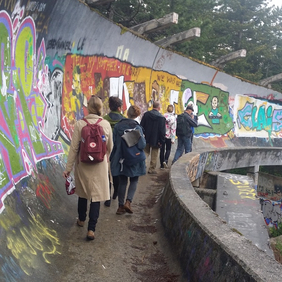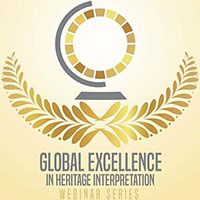This year’s conference could not have been held in a more appropriate location to consider our theme of Engaging with diversity. The ‘Jerusalem of Europe’ at the heart of Bosnia and Herzegovina provided a wealth of opportunities to dive deep into the rich diversity of religion, culture, history and biodiversity exhibited there, and provided a perfect backdrop for us to debate and share our own experiences. Over the three days, we enjoyed more than 30 presentations and workshops as well as a great selection of study visits, which always inspire us and offer chances to reflect with each other.
Diversity was really explored and celebrated, as Michael Glen summed up for us in his closing speech (thank you, Michael!):
‘Topics covered ranged from change, fear, perceptions, conflict, religion, diversity, social cohesion and invasion to reconciliation; from nature, geology, karst country, Roman Empire, Ottoman Empire and culture to disability, education, multi-culture, guiding – and even interpretation. Study tours embraced appalling crimes against humanity, everyday life in Bosnia and Herzegovina, Little Jerusalem and Visočica Mountain, wartime childhood, Gazi Husrev-bey Museum, the National Museum and Trebević Olympic Mountain. In his keynote, Boris Erg helped us to understand the interface between natural and cultural heritage and told us that the more we advance, the more we depend on nature. Matteo Rosati told us that heritage expresses, and is expressed by, diversity, expounded on the importance of intangible heritage and left us with some formidable guidelines to interpretation, which I know Thorsten is keen for IE to develop in association with UNESCO. Taja Vovk van Gaal described the many challenges facing her House of European History from a multi-national planning team restricted to speaking English to displaying their essential original objects within limited space to interpreting in 24 languages and all the while putting visitors at the core of their ethos.’
I enjoyed bringing this programme together, but the biggest reward is hearing from participants what it meant to them and so it is my pleasure to include here some of your own experiences of the conference. Before you read on, I must say a big thank you to our in-country conference manager, Jelena Pekić, and her team from 2MB who organised the conference for us, and Jelena Močević, IE’s Country Coordinator Bosnia and Herzegovina (and now also Vice Chair of the Supervisory Committee).
You can find the plenary speeches on our new Youtube channel: www.youtube.com/channel/UCDbwylo-tJugfsKXIEl21fQ and thank you for sharing some of your experiences from the conference below:
Hamak. Swinging intentionally and accidentally, never staying totally still, yet always finding the right place. That’s what it all came down to. That’s how I would re-entitle not only the workshop on sensory disability (Disability and the Exhibitionary Complex), but also the whole conference. Exactly as I heard it from another participant (Thank you, Gül!), when she was struggling to come up with the English word for what she wanted to say. She didn’t have to. Her co-participants got it quickly and explained it to me. They could feel it before they could grasp it. These were participants from four language families, three alphabets, seven languages: Ñ Ð°Ð¼Ð°Ðº, αιÏÏα, függÅágy, hamak, hammock, hängmatta, Hängematte.
I tended to treat language as a place during this conference, asking fellow delegates which language they were from, as opposed to where they were from. Language was a big factor and actor during our workshop, as we were trying to master the art of description and give voice to our looking, digging collaboratively, struggling to pick the right word at the right time, layering our visual experience, temporarily suspending preconceptions, trying to detect natural and cultural processes. Differences in language, experience, knowledge, interests and viewpoints led to an osmosis of our subjectivities in front of the ‘objects’ we experimented with: the view of the southeastern hills of Sarajevo through the window, a vase, the IE logo. Describing something as deceivingly simple as that logo (thumbs up to the designer!) inadvertently led to poetry. Hamak.
‘Τα ÏÏάγμαÏα ξεÏεÏνοÏν ÏÎ¹Ï Î»ÎξειÏ. Î¤Î¹Ï Î»Ï
Ïάμαι, μÎνοÏ
ν ÏάνÏα ÏίÏÏ, ÏÏÎÏοÏ
ν να ÏÏολάβοÏ
ν αλλά δεν μÏοÏοÏν, η αÏÏÏÏαÏη ÏοÏ
ÏÎ¹Ï ÏÏÏίζει αÏÏ Ïα ÏÏάγμαÏα δεν μειÏνεÏαι ÏοÏÎ. / Things go beyond words. I feel sorry for words, they always lag behind, they run to catch up but they can’t make it, the distance that separates them from things never decreases’. So writes Greek author Dimitris Dimitriadis in ‘Πζάλη ÏÏν ζÏÏν ÏÏιν Ïη ÏÏαγή’ – ‘The Stunning of Animals Before the Slaughter’ (1992). And when he was asked at an interview: ‘If things go beyond words, why do you keep resorting to words?’, he replied: ‘In order to turn them into things’. Full circle. For all of us who struggle with words, description and interpretation. Keep swinging. Hamak. ΤζÎννÏ
Îγγελική ΠαÏαÏÏÏηÏίοÏ
Angheliki Papassotiriou (Greece)
Attending last year’s Interpret Europe conference in KÅszeg was my best academic conference experience from all seven conferences attended in 2018. So, I came to Sarajevo expecting another amazing conference. And it was. Two main reasons make me state this: the IE family and the city. The city is not only about its architecture and its East-West mix, but the people. The people are indeed very warm and hospitable, in spite of their turbulent and painful past. I left Sarajevo not with my soul full of joy, but with a lot of nostalgic thoughts and hope to return to a city less affected by the tragedies of the ’90s.
Florin Nechita (Romania)
Heritage interpretation has recently become one of my research interests. I am especially interested in the interpretation of the heritage of politically underrepresented groups in Turkey, and would like to eventually work on how interpretation could inform policy making. However, I found myself quite isolated as there are not many colleagues, classmates or professors working on the topic. My thesis adviser, who is also interested in heritage interpretation, recommended that I attend the Interpret Europe conference, and I couldn’t be more grateful that I did!
Honestly, before attending the conference, I believed Turkey’s condition related to its plural heritage was singular. During the Interpret Europe conference, I met so many people from all around the world. I got a chance to understand the global issues related to multicultural heritage and observe different approaches to these issues. After hearing about so many different examples from all around the world, including Albania, Belarus, Hungary, Russia, Serbia and the USA, I realised that even though the contexts and actors are different, the issues are very similar. Therefore, communicating, and sharing ideas and experiences will bring us closer to finding common ground.
I believe the most valuable part of the conference, however, was getting to know attendees in less formal contexts during the study visits. I have to admit that I really enjoyed sharing spontaneous laughs on the cable car going up the Trebević mountain with participants I had just met, and sharing a common skepticism about the tunnels leading to Bosnian Pyramids with 15 other colleagues without even having to speak! I am very grateful that I got a chance to join Interpret Europe, and can’t wait to be a part of upcoming events!
Ipek Karaoglu Koksalan (Turkey)
This year in Sarajevo was my first possibility to join the Interpret Europe community. I did not know much about what to expect, I was only sure that I had to present our project, www.journeytothebeginnings.eu for professional interpreters, so I was rather excited. I have met with a strong, but open and supportive community, which welcomed me and answered my doubts and questions I had about my own approach. This is the most precious thing that a community can give me and to share the experience of others. I have learned about the colourful landscape of interpretation, both in the context of natural and cultural heritage, and I have been really inspired by the natural reserves and the work IE experts are doing. Besides being more confident in my current work, I came home with the recognition that my expertise in contemporary art has great opportunities in working together with nature and nature experts. I’m looking forward to starting initiatives in this topic and I hope next year I will be able to join IE again in Estonia and report about our common progress.
Barna Petrányi (Hungary)
Coming home – A warm welcome indeed!
Thank you for such a warm welcome to the 2019 Interpret Europe conference in Sarajevo. It felt like coming home on the first day of the conference when I was greeted by IE friends upon locating the registration desk. I’m also very thankful for the warm greetings given to my colleagues from the Siberian Association for Interpretation – Svetlana Kuklina and Elena Weber.
Sarajevo was a very appropriate place to host the conference with a theme centered around diversity. I didn’t know what to expect coming from the US West Coast having lived during the Siege of Sarajevo at a distance and hearing about it in the news. Only a strong and resilient population could live through that time and recover to greet us warmly today. I found the ‘Jerusalem of Europe’ a fascinating place to explore along with other international interpretive colleagues.
Interpret Europe conferences (this was my third one!) are always a refreshing and illuminating look at the profession from a management level – challenging me to look internally and think about issues at a higher level than most conferences. I came away with more thoughts about the world and what role heritage interpretation plays in it. I’m more of a world citizen now than when I arrived.
Chuck Lennox, Lennox Insites and National Association for Interpretation (USA)
The Sarajevo conference was the first IE conference that I have attended, and I was there presenting a paper, A Survey of Cultural Monuments in Albania: (Post) Socialism’s Effect on Religious Material Diversity. The days of the conference were so intense but really I enjoyed every single presentation and workshop. I had the opportunity to see different approaches of interpretation in different countries. I come from a country where interpretation is not very well shared, so these examples inspired me to use them when going back to my country and to share with other colleagues in museums and art galleries.
I got to know a lot of people from different countries who have been part of Interpret Europe for a long time, so being there and discussing with them gave me a deep understanding of what IE does. Also the site visits made this conference more enjoyable. In two days, I visited two museums that were related to what happened to Sarajevo after the break up of Yugoslavia. We looked at different exhibits there, and guides – who were founders of those museums – guided us and told us more. It was really shocking. I come from a communist country, and I thought that we suffered a very brutal and oppressive regime that could not compare to anything else, but after what I saw and heard on those study tours, I totally changed my mind. I passed by people every day, in different parts of the city, and no-one looked like they were desperate, although the bullets and bombs of the war have left their footprints in a lot of buildings and squares. I left Sarajevo with a lot of memories, a new family, lots of love, a lot of knowledge and I can’t wait for the next conference in Estonia.
Inesa Sulaj (Albania)
Bettina Lehnes is IE’s conference coordinator. She can be contacted at: bettina.lehnes@interpret-europe.net.
To cite this article:
Lehnes, Bettina (2019) ‘Sarajevo memories’. In Interpret Europe Newsletter 2-2019, 6.
Available online: www.interpret-europe.net/fileadmin/Documents/publications/Newsletters/ie-newsletter_2019-2_summer.pdf




